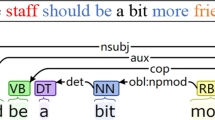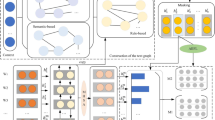Abstract
Graph Convolutional Network (GCN) for aspect-based sentiment classification has attracted a lot of attention recently due to their promising performance in handling complex structure information. However, previous methods based on GCN focused mainly on examining the structure of syntactic dependency relationships, which were subject to the noise and sparsity problem. Furthermore, these methods tend to focus on one kind of structural information (namely syntactic dependency) while ignoring many other kinds of rich structures between words. To tackle these problems, we propose a novel GCN based model, named Structure-Enhanced Dual-Channel Graph Convolutional Network (SEDC-GCN). Specifically, we first exploit the rich structure information by constructing a text sequence graph and an enhanced dependency graph, then design a dual-channel graph encoder to model the structure information from the two graphs. After that, we propose two kinds of aspect-specific attention, i.e., aspect-specific semantic attention and aspect-specific structure attention, to learn sentence representation from two different perspectives, i.e., the semantic perspective based on the text encoder, and the structure perspective based on the dual-channel graph encoder. Finally, we merge the sentence representations from the above two perspectives and obtain the final sentence representation. We experimentally validate our proposed model SEDC-GCN by comparing with seven strong baseline methods. In terms of the metric accuracy, SEDC-GCN achieves performance gains of 74.42%, 77.74%, 83.30%, 81.73% and 90.75% on TWITTER, LAPTOP, REST14, REST15, and REST16, respectively, which are 0.35%, 4.22%, 1.62%, 0.70% and 2.01% better than the best performing baseline BiGCN. Similar performance improvements are also observed in terms of the metric macro-averaged F1 score. The ablation study further demonstrates the effectiveness of each component of SEDC-GCN.







Similar content being viewed by others
Explore related subjects
Discover the latest articles, news and stories from top researchers in related subjects.Data Availability Statement
Data sharing not applicable to this article as no datasets were generated or analysed during the current study.
References
Bahdanau, D., Cho, K., Bengio, Y. (2015) Neural machine translation by jointly learning to align and translate. In Proceedings of the 3rd International Conference on Learning Representations, https://doi.org/10.48550/arXiv.1409.0473
Berka, P. (2020). Sentiment analysis using rule-based and case-based reasoning. Journal of Intelligent Information Systems, 55(1), 51–66. https://doi.org/10.1007/s10844-019-00591-8
Chen, P., Sun, Z., Bing, L., Yang, W. (2017) Recurrent attention network on memory for aspect sentiment analysis. In Proceedings of the 2017 Conference on Empirical Methods in Natural Language Processing (pp. 452–461), https://doi.org/10.18653/v1/d17-1047
Conneau, A., Schwenk, H., Barrault, L., LeCun, Y. (2017) Very deep convolutional networks for text classification. In Proceedings of the 15th Conference of the European Chapter of the Association for Computational Linguistics (pp. 1107–1116), https://doi.org/10.18653/v1/e17-1104
Cui, Y., Chen, Z., Wei, S., Wang, S., Liu, T., Hu, G. (2017) Attention-over-attention neural networks for reading comprehension. In Proceedings of the 55th Annual Meeting of the Association for Computational Linguistics (pp. 593–602), https://doi.org/10.18653/v1/P17-1055
Dong L, Wei F, Tan C, Tang D, Zhou M, Xu K (2014) Adaptive recursive neural network for target-dependent twitter sentiment classification. In Proceedings of the 52nd Annual Meeting of the Association for Computational Linguistics (pp. 49–54), https://doi.org/10.3115/v1/p14-2009
Gu, S., Zhang, L., Hou, Y., Song, Y. (2018) A position-aware bidirectional attention network for aspect-level sentiment analysis. In Proceedings of the 27th International Conference on Computational Linguistics (pp. 774–784), https://aclanthology.org/C18-1066.
Hochreiter, S., & Schmidhuber, J. (1997). Long short-term memory. Neural Computation, 9(8), 1735–1780. https://doi.org/10.1162/neco.1997.9.8.1735
Hou, X., Qi, P., Wang, G., Ying, R., Huang, J., He, X., Zhou, B. (2021) Graph ensemble learning over multiple dependency trees for aspect-level sentiment classification. In Proceedings of the 2021 Conference of the North American Chapter of the Association for Computational Linguistics: Human Language Technologies (pp. 2884–2894), https://doi.org/10.18653/v1/2021.naacl-main.229
Huang, B., Ou, Y., Carley, K.M. (2018) Aspect level sentiment classification with attention-over-attention neural networks. In Proceedings of the 11th International Conference on Social Computing, Behavioral-Cultural Modeling and Prediction and Behavior Representation in Modeling and Simulation (pp 197–206), https://doi.org/10.1007/978-3-319-93372-6_22
Huang, L., Ma, D., Li, S., Zhang, X., Wang, H. (2019) Text level graph neural network for text classification. In Proceedings of the 2019 Conference on Empirical Methods in Natural Language Processing (pp 3442–3448), https://doi.org/10.18653/v1/D19-1345
Huang, L., Sun, X., Li, S., Zhang, L., Wang, H. (2020) Syntax-aware graph attention network for aspect-level sentiment classification. In Proceedings of the 28th International Conference on Computational Linguistics (pp 799–810), https://doi.org/10.18653/v1/2020.coling-main.69
Kalchbrenner, N., Grefenstette, E., Blunsom, P. (2014) A convolutional neural network for modelling sentences. In Proceedings of the 52nd Annual Meeting of the Association for Computational Linguistics (pp. 655–665), https://doi.org/10.3115/v1/p14-1062
Kiritchenko, S., Zhu, X., Cherry, C., Mohammad, S. (2014) Nrc-canada-2014: Detecting aspects and sentiment in customer reviews. In Proceedings of the 8th International Workshop on Semantic Evaluation (pp. 437–442), https://doi.org/10.3115/v1/s14-2076
Li, X., Bing, L., Lam, W., Shi, B. (2018) Transformation networks for target-oriented sentiment classification. In Proceedings of the 56th Annual Meeting of the Association for Computational Linguistics (pp. 946–956), https://doi.org/10.18653/v1/P18-1087
Liang, B., Du, J., Xu, R., Li, B., Huang, H. (2019) Context-aware embedding for targeted aspect-based sentiment analysis. In Proceedings of the 57th Conference of the Association for Computational Linguistics (pp 4678–4683), https://doi.org/10.18653/v1/p19-1462
Liang, B., Su, H., Gui, L., Cambria, E., & Xu, R. (2022). Aspect-based sentiment analysis via affective knowledge enhanced graph convolutional networks. Knowledge-Based Systems, 235, 107643. https://doi.org/10.1016/j.knosys.2021.107643
Linmei, H., Yang, T., Shi, C., Ji, H., Li, X. (2019) Heterogeneous graph attention networks for semi-supervised short text classification. In Proceedings of the 2019 Conference on Empirical Methods in Natural Language Processing (pp 4823–4832), https://doi.org/10.18653/v1/D19-1488
Liu, J., Zhang, Y. (2017) Attention modeling for targeted sentiment. In Proceedings of the 15th Conference of the European Chapter of the Association for Computational Linguistics (pp. 572–577), https://doi.org/10.18653/v1/e17-2091
Ma, D., Li, S., Zhang, X., Wang, H. (2017) Interactive attention networks for aspect-level sentiment classification. In Proceedings of the Twenty-Sixth International Joint Conference on Artificial Intelligence (pp. 4068–4074), https://doi.org/10.24963/ijcai.2017/568
Ma, Q., Yu, L., Tian, S., Chen, E., & Ng, W. W. Y. (2019). Global-local mutual attention model for text classification. IEEE ACM Trans Audio Speech Lang Process, 27(12), 2127–2139. https://doi.org/10.1109/TASLP.2019.2942160
Pennington, J., Socher, R., Manning, C.D. (2014) Glove: Global vectors for word representation. In Proceedings of the 2014 Conference on Empirical Methods in Natural Language Processing (pp. 1532–1543), https://doi.org/10.3115/v1/d14-1162
Pontiki, M., Galanis, D., Pavlopoulos, J., et al. (2014) Semeval-2014 task 4: Aspect based sentiment analysis. In Proceedings of the 8th International Workshop on Semantic Evaluation (pp. 27–35), https://doi.org/10.3115/v1/s14-2004
Pontiki, M., Galanis, D., Papageorgiou, H., Manandhar, S., Androutsopoulos, I. (2015) Semeval-2015 task 12: Aspect based sentiment analysis. In Proceedings of the 9th International Workshop on Semantic Evaluation (pp. 486–495), https://doi.org/10.18653/v1/s15-2082
Pontiki, M., Galanis, D., Papageorgiou, H., Androutsopoulos, I., Manandhar, S., Al-Smadi, M., Al-Ayyoub, M., Zhao, Y., Qin, B., De Clercq, O., et al. (2016) Semeval-2016 task 5: Aspect based sentiment analysis. In Proceedings of the 10th International Workshop on Semantic Evaluation (pp. 19–30), https://doi.org/10.18653/v1/s16-1055
Singh, L. G., & Singh, S. R. (2021). Empirical study of sentiment analysis tools and techniques on societal topics. Journal of Intelligent Information Systems, 56(2), 379–407. https://doi.org/10.1007/s10844-020-00616-7
Sun, K., Zhang, R., Mensah, S., Mao, Y., Liu, X. (2019) Aspect-level sentiment analysis via convolution over dependency tree. In Proceedings of the 2019 Conference on Empirical Methods in Natural Language Processing (pp. 5678–5687), https://doi.org/10.18653/v1/D19-1569
Tang, D., Qin, B., Feng, X., & Liu, T. (2015). Target-dependent sentiment classification with long short term memory.https://doi.org/10.48550/arXiv.1512.01100
Tang, D., Qin, B., Feng, X., Liu, T. (2016a) Effective lstms for target-dependent sentiment classification. In Proceedings of the 25th International Conference on Computational Linguistics (pp. 3298–3307), https://doi.org/10.48550/arXiv.1512.01100
Tang, D., Qin, B., Liu, T. (2016b) Aspect level sentiment classification with deep memory network. In Proceedings of the 2016 Conference on Empirical Methods in Natural Language Processing (pp. 214–224), https://doi.org/10.18653/v1/d16-1021
Wagner, J., Arora, P., Cortes, S., Barman, U., Bogdanova, D., Foster, J., Tounsi, L. (2014) DCU: aspect-based polarity classification for semeval task 4. In Proceedings of the 8th International Workshop on Semantic Evaluation (pp. 223–229), https://doi.org/10.3115/v1/s14-2036
Wang, G., Ying, R., Huang, J., Leskovec, J. (2021) Multi-hop attention graph neural networks. In Proceedings of the Thirtieth International Joint Conference on Artificial Intelligence (pp. 3089–3096), https://doi.org/10.24963/ijcai.2021/425
Wang, Y., Huang, M., Zhu, X., Zhao, L. (2016) Attention-based lstm for aspect-level sentiment classification. In Proceedings of the 2016 Conference on Empirical Methods in Natural Language Processing (pp. 606–615), https://doi.org/10.18653/v1/d16-1058
Xiao, L., Xue, Y., Wang, H., Hu, X., Gu, D., & Zhu, Y. (2022). Exploring fine-grained syntactic information for aspect-based sentiment classification with dual graph neural networks. Neurocomputing, 471, 48–59. https://doi.org/10.1016/j.neucom.2021.10.091
Xue, W., Li, T. (2018) Aspect based sentiment analysis with gated convolutional networks. In Proceedings of the 56th Annual Meeting of the Association for Computational Linguistics (pp. 2514–2523), https://doi.org/10.18653/v1/P18-1234
Yang, M., Tu, W., Wang, J., Xu, F., Chen, X. (2017) Attention based LSTM for target dependent sentiment classification. In Proceedings of the Thirty-First AAAI Conference on Artificial Intelligence (pp. 5013–5014), https://dl.acm.org/doi/10.5555/3297863.3297977.
Yao, L., Mao, C., Luo, Y. (2019) Graph convolutional networks for text classification. In Proceedings of the 33rd AAAI Conference on Artificial Intelligence (pp. 7370–7377), https://doi.org/10.1609/aaai.v33i01.33017370
Zhang, C., Li, Q., Song, D. (2019) Aspect-based sentiment classification with aspect-specific graph convolutional networks. In Proceedings of the 2019 Conference on Empirical Methods in Natural Language Processing (pp. 4567–4577), https://doi.org/10.18653/v1/D19-1464
Zhang, M., Qian, T. (2020) Convolution over hierarchical syntactic and lexical graphs for aspect level sentiment analysis. In Proceedings of the 2020 Conference on Empirical Methods in Natural Language Processing (pp. 3540–3549), https://doi.org/10.18653/v1/2020.emnlp-main.286
Zhou, P., Qi, Z., Zheng, S., Xu, J., Bao, H., Xu, B. (2016) Text classification improved by integrating bidirectional LSTM with two-dimensional max pooling. In Proceedings of the 26th International Conference on Computational Linguistics (pp. 3485–3495), https://doi.org/10.48550/arXiv.1611.06639
Zhu, X., Zhu, L., Guo, J., Liang, S., & Dietze, S. (2021). Gl-gcn: global and local dependency guided graph convolutional networks for aspect-based sentiment classification. Expert Systems with Applications, 186, 115712. https://doi.org/10.1016/j.eswa.2021.115712.
Acknowledgements
This work was supported by the National Natural Science Foundation of China [grant number 62141201]; and the Federal Ministry of Education and Research [grant number 01IS21086].
Author information
Authors and Affiliations
Corresponding author
Ethics declarations
Conflicts of interest
The authors declare that they have no conflict of interest.
Rights and permissions
Springer Nature or its licensor holds exclusive rights to this article under a publishing agreement with the author(s) or other rightsholder(s); author self-archiving of the accepted manuscript version of this article is solely governed by the terms of such publishing agreement and applicable law.
About this article
Cite this article
Zhu, L., Zhu, X., Guo, J. et al. Exploring rich structure information for aspect-based sentiment classification. J Intell Inf Syst 60, 97–117 (2023). https://doi.org/10.1007/s10844-022-00729-1
Received:
Revised:
Accepted:
Published:
Issue Date:
DOI: https://doi.org/10.1007/s10844-022-00729-1




